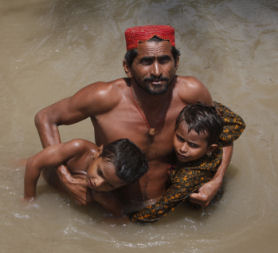More affected by Pakistan floods than tsunami
As the number of people directly affected by the Pakistan floods exceeds those hit by the 2004 tsunami, Science Correspondent Tom Clarke examines the weather patterns which could be to blame.

The floods have affected 13m people, according to the UN, affecting an area twice the size of Britain.
1,600 people have died, and around two million are thought to be homeless following the floods, the worst in the area for 80 years.
Habib Malik from the aid charity Islamic Relief has returned from Pakistan where he filmed his experience in helping the victims. He told Channel 4 News of the agony and pain he had witnessed.
Mr Malik, who was an aid worker during the 2004 tsunami and the 2005 Kashmir earthquake, said: “To me this is one of the worst scenes of human suffering”.
He said it was a race against time for aid workers trying to reach flood victims, battling Pakistan’s “totally destroyed infrastructure system”.
Landslides caused by the floods have hampered relief efforts further, particularly in the Swat valley. Heavy rains have also grounded some helicopters.
Maurizio Giuliano, spokesman for the UN Office for the Coordination of Humanitarian Affairs, said: “It’s hard to get supplies there. I would like to emphasise we are moving by foot or donkey. We are making all kinds of possible efforts. We are unable to get in to most places of Swat Valley.”
Turbo-charged monsoon?
Normally the jet stream is a giant loop of high speed winds that whip round the upper atmosphere, writes Science Correspondent Tom Clarke.
The jet stream isn't involved in day to day weather - it's too high up - but because it pushes the atmosphere around it's very important in steering large scale weather patterns below.
The stream has split in two. One arm has gone north, another south. The patch in the middle is Russia's drought. A circulating pattern of air has been sitting over Russia for far longer than normal, causing the extreme temperatures and wildfires they've had there.
But what's happening over Pakistan is even stranger. The southern arm of the Jet stream has looped down so far it has crossed over the Himalayas into north western Pakistan. Experts at the Met Office tell me this is very unusual.
And the result is that the fast moving jets stream winds high up has helped suck the warm, wet, monsoon air even faster and higher into the atmosphere - and that has caused rains like no-one can remember. It has turbo charged the monsoon if you like. They're not sure that's ever happened before.

Peter Kessler, spokesman in Islamabad for the UN’s refugee agency the UNHCR, told Channel 4 News: “The situation is absolutely catastrophic.
“This is a crisis twice the size of Britain in terms of the area that’s affected – some 14 to 16 million people according to government estimates. It’s just astounding.
“We’re going to be finding many areas that still have not been reached for days, possibly weeks to come. But it is vital that donors, governments, private individuals come to the aid of people in Pakistan right now, make contributions and ensure that aid agencies can get things in.”